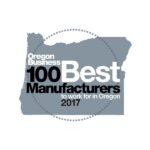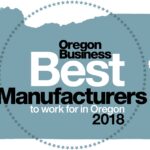A survey of 500 Oregon and Washington manufacturers says seven in 10 see a brighter year ahead.
The vast majority of Northwest manufacturing employers have a positive outlook on the year ahead, per a survey commissioned by Schwabe, Williamson & Wyatt, P.C., and Aldrich CPAs + Advisors, and released by the firm earlier this month. The firm first commissioned the survey in 2018 but took a pause last year due to the COVID-19 pandemic, says Michael Cohen, Schwabe’s manufacturing, distribution and retail industry group leader.
That short time frame — and the fact that more than 500 companies responded to the survey this year, as opposed to 100 in 2018 — doesn’t lend itself to a clean, apples-to-apples comparison. But Cohen does note that overall confidence was lower this year than in 2018. It’s just not as bad as he anticipated.
“I was expecting perhaps a significant dip, given the pandemic-related challenges, and it really only dipped very slightly,” Cohen tells OB.
This year seven out of 10 survey respondents said they had a positive outlook on the coming year, versus eight out of 10 three years ago.
“I think it indicates that companies in the manufacturing sector in the Northwest do feel very rosy still about their prospects. Demand is clearly very high for products kind of all across the board, despite the headlines that we’re all reading every day about the supply chain being broken, and how difficult it is to retain and attract a qualified workforce — all those kinds of challenges that you hear about constantly these days,” Cohen says. “Despite all of that, manufacturers are still doing quite well and have a positive outlook.”
According to the survey, 25% of survey respondents had to lay off or furlough employees due to the COVID-19 pandemic, and 13% instituted a hiring freeze. More than half instituted a remote or hybrid work policy for some employees, and 52% changed or reconfigured employee workspaces.
The firm surveyed companies in Oregon and Washington, and according to survey results, Washington-based respondents were more optimistic — with 75% reporting a positive outlook — than their Oregon counterparts, 70% of whom had a positive view of the coming year. The survey results also noted that larger firms tended to report a more positive view overall, with 80% of companies with $20 million or more in revenue expressing a positive outlook, versus 70% of those in the $5 million to $30 million range and 65% of those with revenues under $5 million projecting a bright future for the year ahead.
Seven out of 10 manufacturers said finding skilled, qualified labor is their biggest challenge. And survey respondents were far more concerned about employee compensation in 2021 than they were three years ago, 66% saying maintaining competitive compensation or benefit offerings is one of their biggest challenges. In 2018 just 26% of employers said compensation was an issue for them.
But most companies surveyed say they plan on hiring in the near future: 70% say they will add more full-time employees over the next year, and about half will add more part-time or contract workers, the survey says.
Supply-chain challenges also likely cast a cloud over survey respondents’ views of the future, though Cohen also says he has heard some manufacturers have begun to “retool” their businesses and try to make more at home, rather than relying on overseas components.
“I think we’ve revealed over the course of the last 20 months [that the manufacturing sector] does have a certain amount of fragility to it, and can be subject to two problems that come up in the supply chain and workforce arenas most pronounced, sadly,” Cohen says. “But I think, really, the optimism that still exists and the predictions that these survey respondents were giving about how many people they intended to employ over the course of the next 12 months is a very positive sign for the Northwest generally and for employees and the workforce. I mean, the responses we got on hiring alone were pretty remarkable.”
Cohen says Schwabe started undertaking the survey because it represents a large number of clients in the manufacturing sector and wanted to help them by gathering data they could use. American City Business Journals collected the responses.






